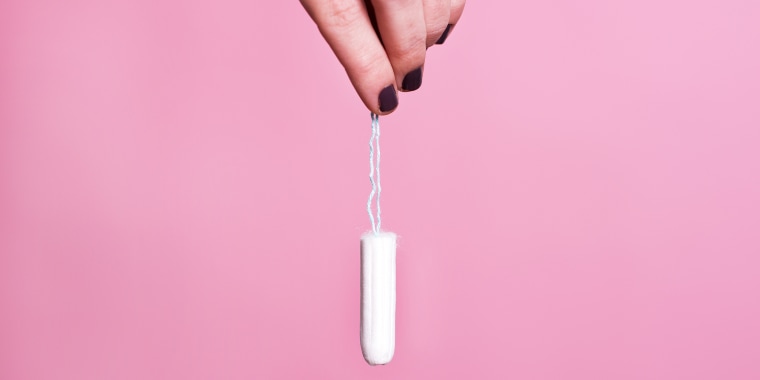Most women probably don't worry a lot about their tampons, but should they?
The sleek tubular contraptions have been around commercially since the 1930s in the U.S. and they've been doing their job of absorbing menstrual flow since. What’s to worry about? Plenty, according to some environmental health activists. But other experts think we may need to chill.
At the heart of the debate is ingredient transparency. Tampons, which generally are made of cotton, rayon or a blend, are considered medical devices by the government and ingredients don’t have to be listed.
That, according to activists, means tampons could potentially be monthly delivery devices for chemicals that could quickly enter the body via the permeable tissue of the vagina and lead to irritation and allergic reactions, endocrine system disruptions, even cancer.
Little long-term science
The debate has been going on for years and the operative word here is “may” because there’s actually very little long-term science looking at the chemo-hazards of that tiny piece of compressed fabric.
“It’s tough to answer patient questions with little data,” Dr. Michael Cackovic, maternal and fetal medicine specialist at The Ohio State University Wexner Medical Center, told TODAY.
Of particular concern to him are any long-term effects of chemicals on the vaginal microbiome. Like the gut, the vagina is host to microorganisms that play a role in women’s health.
“It could potentially be an issue, especially in terms of reproductive health, but menstrual products are a personal choice and some women really like tampons,” he said.
That’s an understatement. Tampon usage in the U.S. is among the highest in the world.
FDA labeling requirements
To be fair, tampons don’t make it to market without some checks.
Tampons go through a process of FDA clearance for safety and effectiveness, including material safety testing, absorbency testing and microbiological testing, explained FDA spokeswoman Deborah Kotz in an email.
FDA requirements for tampon labeling include providing information regarding tampon absorbency and toxic shock syndrome (TSS), a very rare (affecting about one in 100,000 cases among menstruating women), but potentially fatal bacterial infection.
“Tampons are safe. No company wants to put out a product that’s going to endanger women,” said C. Tucker Helmes, executive director of the industry trade association, the Center for Baby and Adult Hygiene Products.
Perhaps due to consumer questions, some manufactures like Kimberly-Clark, which makes Kotex brands, and P&G, makers of Tampax products, go into some detail on their ingredient list on their websites.
Several years ago, the government commissioned a study to address claims that dioxin, a nasty persistent organic pollutant that is found everywhere — even in food — could be found on tampons. The study found regular tampon use would provide less than 0.2 percent of a woman's recommended maximum intake of dioxins for a month and doesn’t pose a health risk.
But it’s a woman’s lifetime exposure that worries some experts.
“Sure, dioxins are in the environment, but when a woman uses several tampons throughout the day and somewhere in the neighborhood of 11,000 during her reproductive life, that’s a lot of dioxin exposures,” said Philip Tierno, Jr., clinical professor of microbiology and pathology at NYU School of Medicine. His research in the 1980s during the height of the TSS scare helped show the association between TSS and some materials found in high-absorbency tampons, which were pulled from the market.
With consumers concerned about chemicals and additives in food and personal items, advocacy groups like Women’s Voices for the Earth (WVE) want transparency in labeling and more transparent science looking at the potential health hazards of feminine hygiene products, including tampons, pads, washes, and douches, said Alexandra Scranton, WVE’s director of science and research. Even some politicians like Rep. Grace Meng (D-NY) and Rep. Carolyn Maloney (D-NY) have jumped on the feminine product disclosure and research bandwagon.
What’s a woman to do?
Based on her patient experience, feminine hygiene choices are usually determined by comfort, convenience and cost, said Dr. Kimberly Gecsi, program director of obstetrics and gynecology at UH Cleveland Medical Center. With the available information and regulation, she is perfectly comfortable with her patients using any menstrual product they want, based on what they can afford.
“Tampons aren’t a threat,” she said. “They are regulated and women have enough to worry when it comes to their health, like access to care and being able to afford care. Let’s not add tampons to their list of worries.”
Although he wants to know more, Dr. Cackovic of the Wexner Medical Center isn’t telling his tampon-using daughters, wife or patients to stop. He’s not telling anyone to go organic either, because there’s no research showing that’s better, he said.
Four ways to help your personal menstrual health and hygiene:
1. Change tampons every four to eight hours (no matter what type you use)
2. Wash your hands before and after insertion
3. Choose the lowest absorbency for personal needs
4. Switch to pads on occasion during your period, especially if you are going to conk out for more than eight hours)
“As a gynecologist, I wish I had the perfect answer for women, but I don’t,” Cackovic said. “I think women do need to know there are some good questions, but not a lot of good answers.”


